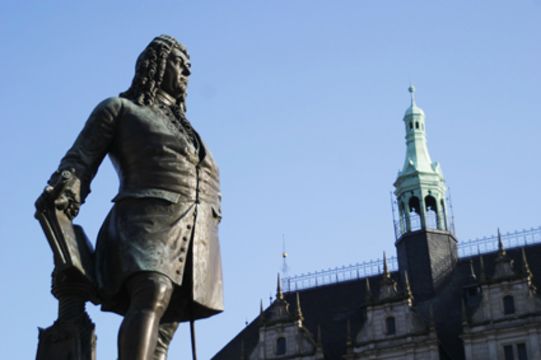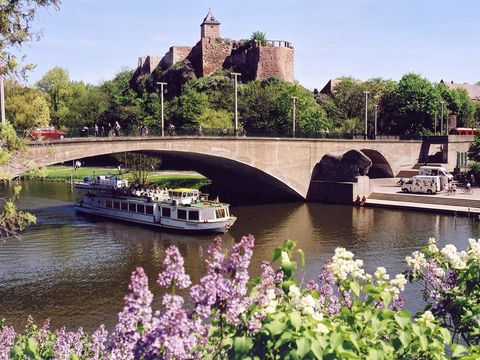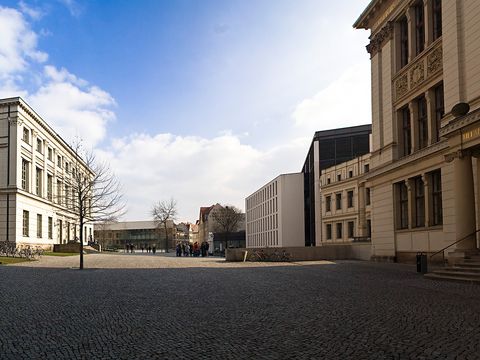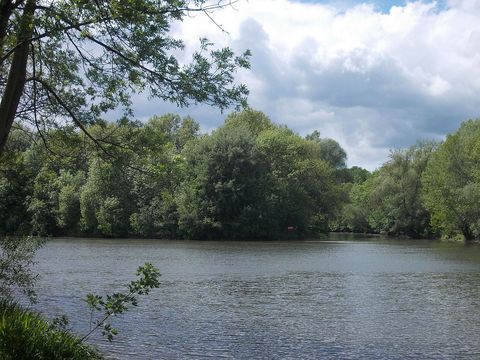Halle has a stylish town centre, plenty of green areas and numerous narrow streets where the architecture from several epochs has been preserved. There are lots of nice spots along the river Saale which runs through the town. Low rent and the proximity to the city of Leipzig make Halle a great place to study in.
Facts
238,762 Inhabitants ¹
22,026 Students ²
3 Higher education institutions ²
WELCOME TO HALLE
Halle is a relatively small town, but this doesn’t mean it’s a dull or rural town. On the contrary, you’ll feel like you’re on a huge campus here. The various institutes and libraries are spread all over town.
The Weinberg Campus is an important technology and start-up centre in eastern Germany. The , which were established in 1698 as a welfare and educational organisation, are today a centre of social-humanist education in Germany. The German National Academy of Sciences , one of the world’s oldest scientific academies, is also based in Halle.
In addition to these institutes, the town also boasts museums and music schools. Halle has the first Beatles Museum in the world! And at the Halloren World of Chocolates you can create your own delicious sweets. The and the Long Science Night are great opportunities to explore the museums in a relaxed atmosphere. Halle is heavily influenced by many different art and cultural projects. Composer George Frideric Handel came from Halle. Traditional festivals, such as the , frequently takes place in his honour.
Tip
If you want to get to know new people, the Peissnitz Island is an ideal place!
Halle became a wealthy town as a result of the salt trade. The preserved ramparts of the medieval castle give Halle its historical ambience. Other town landmarks include “Unserer Lieben Frauen“ and the “Roter Turm“, a free-standing bell tower. Narrow alleyways wind through the town. In addition to the restored town centre, the surrounding districts all add to Halle’s charm. In the Paulusviertel, a student district, you’ll find the kind of villas and houses that have long since been torn down in many other towns in Germany.
Interview
CARMEN FROM EL SALVADOR
LIVING IN HALLE
Halle is an ideal place to study in because the town is relatively small. You can cycle almost everywhere. And rent prices are below the German average.
In the summer months, life in Halle takes place on the streets. The pub-lined Ulrichstrasse is especially popular. Among the rows of houses in the Paulusviertel, cosy bars have established themselves. Here, you can get together with fellow students in a homely living-room atmosphere.
Just a few minutes from Universitätsplatz is the start of Peissnitz Island. This is where the rivers Saale and Saline flow. Several kilometres long, this expansive park is one of the most popular meeting points for students. It’s just the right place for sporting activities, studying, barbecuing and meeting new people. Lots of young people hang out here on the lawns in the evenings.
One thing that can be said about the nightlife here is that it’s cheap!
One annual highlight is the final semester party of the art and design students. Burg Giebichenstein and the Design-Campus then turn into one huge party zone where everyone dances outdoors until dawn.
There are also several nice spots within the town on the banks of the river Saale where you can relax and unwind. At Hufeisensee, you’ll feel like you’re in the middle of the country. You can get to the lake from Marktplatz in just 15 minutes by public transport. And it’s just a 20-minute train ride to , a buzzing city with several higher education institutions.
Tags
#StPauli #Multicultural #HarbourCityGateToTheWorld




